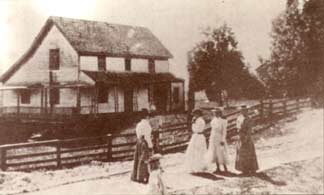 |
 |
 |
 |
Cedar Mill HistoryIntroduction |
|
Used with the permission of Introduction
Although Cedar Mill was originally inhabited by A-tfa'-lati Indians, Samuel Walters gained distinction in 1847 as the first white settler to arrive in the area. For the next century the locality retained a rural identity, until the pressures of increasing population following the Second World War began to change the nature of the farming community. While we thought it best to close the story in these years, we made a few exceptions in order to carry to the present the accounts of pioneer descendants who continue to reside in the area. In addition, several themes that had their origin before 1947 also have been carried forward. Our hope is that future historians will complete the history of the community. One significant fact that bears mentioning is that although Cedar Mill was never an incorporated city, it has continued to retain its own identity. In the beginning, gently rolling slopes of heavy timber served as a source of supply for the cedar mill on Cornell Road. A few years later, with Cornell and Barnes connected, the area was a vital link in the route from Portland to Hillsboro. A large portion of the logged-off forest was transformed into productive farm acreage by new settlers, including many from Germany and Switzerland. More recently, much of the farm land has been broken into parcels for urban development. And at the present time a precarious balance of rural and urban interests is evident in Cedar Mill. Despite shifting land use and increasing population pressures, a remarkable sense of community has been retained since the period of early settlement. Pioneer men and women were resourceful in developing the area. Their descendants, and hundreds of others arriving later, worked to improve the community through social, political, economic and religious pursuits. In compiling the varied history of Cedar Mill, facts and testimony from at least several hundred sources were used but we were frustrated by a noticeable lack of information in some aspects of community life. Perhaps the biggest disappointment was the absence of statistical data and legal records of pioneer women and second-generation female settlers. It became relatively easy to document activities of the male members of the community, but in dealing with their wives and daughters, we were largely dependent on what we gathered from census, marriage and cemetery records. Fortunately, we were able to compensate for this lack of data by using the previous researches of earlier Cedar Mill historians. Notes assembled by the late H. Ross Findley for a community history were a valuable asset in our study. Excerpts from the work incorporated in the following pages have been used with permission of Findley family decedents. Another survey of the area which aided our analysis was assembled by Gertrude Walters Pearson Landauer. Her memoirs recapture events in the community beginning with the arrival of her grandfather, Samuel Walters, the first white settler in Cedar Mill. Further assistance was obtained from Hazel P. Young who kindly shared with us her research notes and photographs of the area. Much of her documented studies have been reproduced in the Beaverton Valley Times and the Hillsboro Argus. Using the available information, we have tried to record the unique history that distinguishes Cedar Mill. A number of fourth and fifth generation pioneer descendants continue to reside in the area, and to these people and countless other community builders of the past, we say "thank you" for sharing your heritage. It has been a memorable and thoroughly enjoyable experience to research the roots of Cedar Mill. Linda S. Dodds |
About Cedar Mill | Business
Directory | Cedar Mill Memories | Community
Calendar | Government | Organizations
| Public Services | Site
Index
